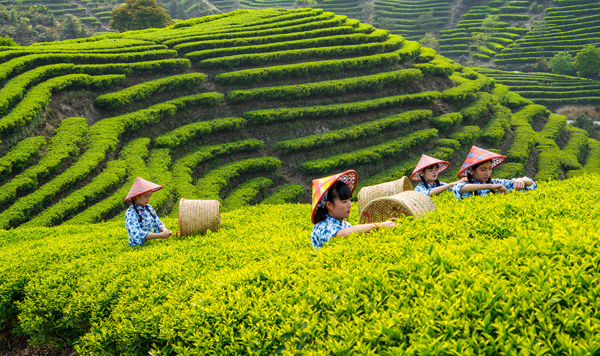Modern agriculture and tourism bring rural areas bright future
Chaozhou in South China's Guangdong province has explored how to vitalize rural areas with its own features and made modern agricultural industries the key.
It is building five large modern agricultural parks involving tea, aquatic products and fruits to promote the upgrading of traditional sectors. It is also developing a large goose species-lion-head goose or African goose-conservation field to boost popularity for the breed.
The city government plans to form a Cantonese-style preserved fruit industry, with an annual output value of 10 billion yuan ($1.55 billion). It would comprise planting, processing, logistics, sales, research and development, and industrial cooperation.
Local officials said the region's agriculture and rural areas were in sound development conditions in recent years. The output value of its primary sector increased from about 13.07 billion yuan in 2018 to nearly 18.45 billion yuan last year.
The disposable income of its rural residents per capita rose from 14,945 yuan in 2018 to 17,266 yuan in 2020. The amount for the first half of this year reached 10,765 yuan.
The city's tea plantations stretch to about 15,333 hectares and their yield was 15,300 metric tons in the first six months, a year-on-year rise of 15.1 percent. Its vegetable yield during the period was 268,900 tons, a-year-on-year increase of 2.9 percent.

Farmers work at a mountainous tea plantation in Chaozhou. WANG LI/FOR CHINA DAILY
It plans to develop agriculture worth 100 billion yuan focusing on dancong (single bush) tea, a semi-fermented oolong tea; livestock; poultry and Raoping county's aquatic products. Its modern agriculture system will comprise industrial clusters among counties, industrial parks and specialty products from villages.
Chaozhou has set up a development work council and a research institute for the dancong tea sector. It has also founded a guild of Chaozhou tangerines in March, and another for lion-head geese in August.
It held the first Chaozhou tangerine cultural festival from Jan 31 to Feb 2. The festival involved online exhibitions and live promotions to recommend the fruits to netizens in Guangdong province and even nationwide. Offline activities where producers and sellers made direct contact were also held during the festival.
The Chaozhou tangerine industrial development forum at the event invited experts from Guangdong's and Chaozhou's research institutions and fruit-farmer households to discuss how to promote the sector's development. This included aspects such as planting technology management and brand protection.
Chaozhou has fostered new agricultural business models and rural tourism demonstration areas. Guikeng in Xiang qiao district was named as a beautiful village ideal for leisure by the Ministry of Agriculture and Rural Affairs last year.
Fenghuang town in northern Chaozhou is noted for its high and steep mountains, the houses of the She ethnic group and fragrant dancong tea. It can produce more than 5,000 tons of tea and the output value can surpass 1 billion yuan annually. The town houses more than 80 tea companies and 50-plus specialized tea cooperatives. Its tea sells to more than 60 countries and regions.
The integration of tea and tourism has become a new engine for rural prosperity in Fenghuang. As a pilot town for digital village development in Guangdong, the town has planned several countryside sightseeing and cultural tourism routes. It also promoted repair projects for Red historical and cultural heritage sites, such as the Fenghuang Mountain revolution memorial park.



 Print
Print Mail
Mail

